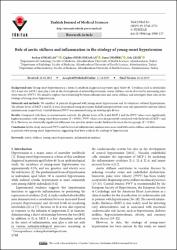Role of aortic stiffness and inflammation in the etiology of young-onset hypertension
Abstract
Background/aim: Young-onset hypertension is a form of condition diagnosed in patients aged below 40. Cytokines such as interleukin (IL)-6 and also MCP-1 may play a role in the development of arterial hypertension. Aortic stiffness can be detected by measuring pulse wave velocity (PWV). We aimed to explore the relationship between inflammation and aortic stiffness and investigate their roles in the etiology of young-onset hypertension. Materials and methods: We enrolled 16 patients diagnosed with young-onset hypertension and 16 volunteers without hypertension. The plasma levels of MCP-1 and IL-6 were determined using an enzyme-linked immunosorbent assay and quantitative enzyme-linked immunoassay, respectively. Carotid-femoral PWV was measured using an arteriograph device. Results: Compared with those in normotensive controls, the plasma levels of IL-6 and MCP-1 and the PWV values were significantly higher in patients with young-onset hypertension (P < 0.001). PWV values were also positively correlated with the levels of MCP-1 and IL-6. However, no statistically significant difference was noted in intima-media thickness between the two groups (P = 0.224). Conclusion: In this study, increased PWVs and the levels of inflammation markers were associated with aortic stiffness and inflammation in patients with young-onset hypertension, suggesting they have a role in the etiology of hypertension.
Source
Turkish Journal of Medical SciencesVolume
49Issue
6URI
https://doi.org/10.3906/sag-1908-137https://app.trdizin.gov.tr/makale/TXpNM01EWTVPUT09
https://hdl.handle.net/20.500.12933/455
















